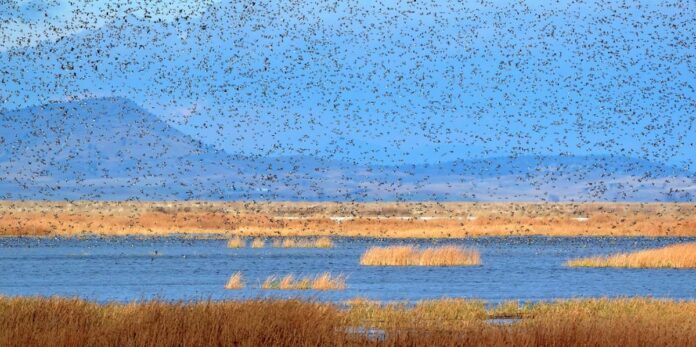Water allocations came at a crucial time for habitat recovery
In 2021, the Tule Lake NWR ran dry for the first time in recorded history. Lower Klamath NWR was not much better off, falling to some of its lowest recorded levels. These wetland landscapes, the first stop on the Pacific Flyway for migrating waterfowl, were in serious trouble.
Restoring the refuges to their peak condition is a top priority for Ducks Unlimited (DU), and doing so in a way that provides multiple benefits beyond just waterfowl but to fish, farms, and other wildlife.
In March, DU collaborated with Tulelake Irrigation District to activate D-Plant pumping station in the Klamath Basin. D-Plant pumped much-needed water from Tule Lake into Lower Klamath National Wildlife Refuge for the first time in four years.
Historically, 80% of the water that reaches Lower Klamath came through D-Plant, making it the most important water source for the nation’s first wildlife refuge for waterfowl.
“The water delivery in March created the best spring habitat conditions the refuges had seen in nearly a decade,” McCreary said. “And the birds responded.”
By May, more than 100,000 waterfowl had flocked to the refuges.
“We learned this year that the effects of rehydrating our dry refuges is textbook wetland ecology,” McCreary said. “Build it and they will come- and the birds did. We also learned that wetlands provide multiple benefits but need our careful attention. They need water, and it takes the whole Klamath Basin community to make that possible.”
U.S. Fish and Wildlife staff reported at least 6,000 birds were banded in Lower Klamath NWR in less than a week, indicating the refuge is on track for a significant production year.
On Lower Klamath NWR, Gadwalls and Redheads are currently the most banded birds. USFWS also reports large numbers of Northern Pintail, Green-Winged Teal, Hooded Mergansers, and Ring-Necked ducks.
With critically low water levels in the refuges, the emergence of avian influenza threatened to topple this progress. By mid-August, hundreds of birds were showing signs of an avian botulism outbreak, making matters worse.
Immediate action was critical. The broader Klamath Watershed Community quickly increased water allocation to the refuges, that have now slowed the disease progression for countless birds and revitalized the habitat for broods on the verge of fledging.
U.S. Fish and Wildlife staff on the refuges used pumping infrastructure engineered by DU to recirculate water in Lower Klamath NWR, capitalizing on these inflows to keep the Basin’s wetlands healthy and productive.
A brighter future for the Klamath Basin
The Klamath Basin was once dominated by wetlands; now, the Basin’s wetlands are largely gone or leveed off from their rivers. DU is working toward a comprehensive, multi-beneficial watershed solution that re-integrates wetlands back into the Basin’s hydrology and ecology. DU believes that a collaborative effort toward a more cohesive ecosystem, one that takes a common-sense approach to wetland management, is the recipe for success.
DU is working to find ways that the refuges can be an added benefit to listed fish recovery and farm sustainability, not just waterfowl and wildlife habitat. In that pursuit, DU is putting new water management pumps on the ground at Tule Lake and Lower Klamath NWRs, collaborating with partners to increase the potential of Tule Lake to support waterfowl, farms, and fish; and improving the water management options at Lower Klamath to have the maximum possible benefit.
Furthermore, this fall, in partnership with the Fish and Wildlife Service, DU will complete construction on largest freshwater wetland restoration project in the western United States at Barnes- Agency , which will reconnect nearly 14,000 acres of former wetlands with the northern arm of Upper Klamath Lake. This project will provide long-term, multi-beneficial solutions for the health of the Basin.
The people who call the Klamath Basin home are building a brighter future, and DU is proud to be part of that effort. DU is grateful to the broader Klamath Watershed community, including our Tribal Nation and irrigation community partners, for making these endeavors a reality.
To support DU’s unwavering commitment to the people and wildlife of the Klamath Basin, please visit ducks.org/conservation/du-conservation-initiatives/klamath-basin-initiative.




